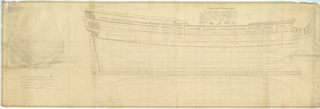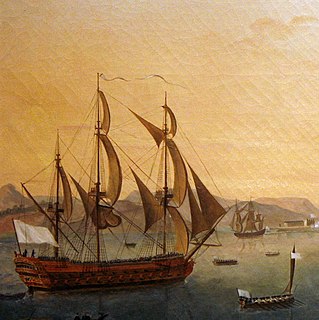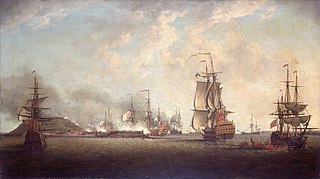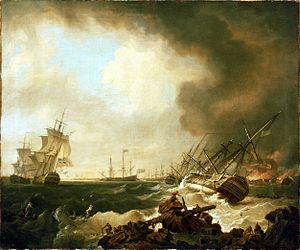
HMS Vanguard was a 90-gun second-rate ship of the line of the Royal Navy, built at Portsmouth Dockyard and launched in 1678.

HMS Vanguard was a 70-gun third rate ship of the line of the Royal Navy, launched on 16 April 1748. She was built by Philemon Ewer at his East Cowes yard on the Isle of Wight to the draught specified by the 1745 Establishment, at a cost of £8,009. She was the fourth vessel of the Royal Navy to bear the name Vanguard.

HMS Monmouth was a 66-gun third-rate ship of the line of the Royal Navy, and was likely named for James, Duke of Monmouth. She served from 1667 to 1767, winning ten battle honours over a century of active service. She was rebuilt a total of three times during her career—each time effectively becoming a completely new ship.

HMS Warspite was a 74-gun third rate ship of the line of the Royal Navy, launched on 8 April 1758 at Deptford.

HMS Panther was a 60-gun fourth-rate ship of the line of the Royal Navy, launched on 22 June 1758 at Chatham Dockyard.

HMS Duke was a 90-gun second-rate ship of the line of the Royal Navy, launched on 13 June 1682 at Woolwich Dockyard.

HMS Prince was a 100-gun first rate ship of the line of the Royal Navy, built by Phineas Pett the Younger at Deptford Dockyard and launched in 1670.

Bienfaisant was a 64-gun ship of the line of the French Navy, launched in 1754.

Belliqueux was a 64-gun ship of the line of the French Navy, launched in 1756.

HMS Falkland was a 50-gun fourth-rate ship of the line of the Royal Navy, built by Holland of New Castle, New Hampshire, and purchased by the navy in 1696.

HMS Oxford was a 54-gun fourth-rate ship of the line of the Royal Navy, built by Francis Baylie in Bristol and launched in June 1674. Her guns comprised twenty-two 24-pounders on the lower deck, with twenty-two large sakers (8-pounders) on the upper deck and ten smaller sakers (5-pounders) on the quarter deck.
President was a 38-gun fourth rate frigate of the Royal Navy, originally built for the navy of the Commonwealth of England by Peter Pett I at Deptford Dockyard, and launched in 1650.

HMS Captain was a 70-gun third rate ship of the line of the Royal Navy, launched at Woolwich Dockyard in 1678.

HMS Essex was a 70-gun third rate ship of the line of the Royal Navy, launched at Blackwall Yard in 1679.

HMS Expedition was a 70-gun third-rate ship of the line of the Royal Navy, launched at Portsmouth Dockyard on 10 September 1679.

HMS Nassau was a 70-gun third rate ship of the line of the Royal Navy, built at Portsmouth Dockyard and launched on 9 January 1706.
HMS Sunderland was a 60-gun fourth rate ship of the line of the Royal Navy, built to the 1719 Establishment at Chatham Dockyard, and launched on 30 April 1724.

HMS Defiance was a 58-gun fourth rate ship of the line of the Royal Navy, built to the dimensions laid out in the 1741 proposals of the 1719 Establishment at Deptford, and launched on 12 October 1744.

HMS Harwich was a 50-gun fourth rate ship of the line of the Royal Navy, built to the dimensions laid down in the 1741 proposals of the 1719 Establishment at Harwich, and launched on 22 December 1743.

HMS Dorsetshire was a 70-gun third-rate ship of the line of the Royal Navy, built at Chatham Dockyard to the draught specified by the 1745 Establishment, amended in 1754, and launched on 13 December 1757.



















